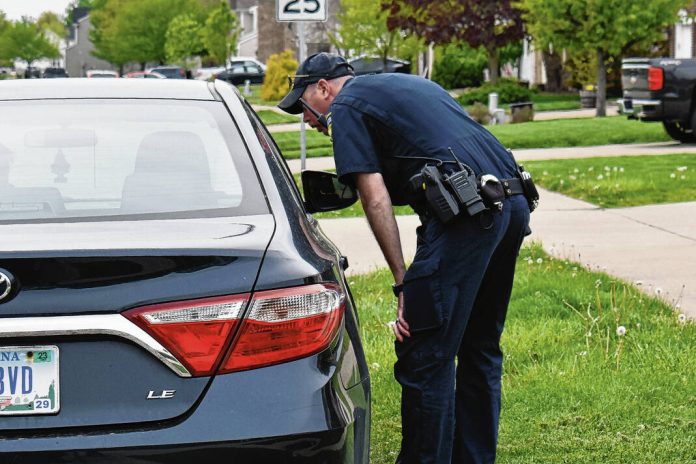A study of Greenwood Police traffic stops shows no evidence of racial or ethnic profiling by the department as a whole. However, the study found “weak and inconsistent” evidence of bias among a small group of former officers.
Results of the 113-page study by Dolan Consulting Group were posted Friday on the city’s website at greenwood.in.gov/police. The police department hired the group in October 2023 to conduct the $40,000 study, to determine if evidence existed that any racial or ethnic groups were treated in a disproportionally biased manner.
The study comes after the department conducted a July internal investigation resulting from the alleged improper use of mobile data computers by five of its officers.
As a result of the investigation, police officials compiled a 5,320-page document containing instant messages sent and received by the group of officers from July 14, 2021 to July 14, 2023. Within the document are over 100 exchanges between the officers containing derogatory language that were sent on department equipment. The messages contained slurs referring to African Americans, Jewish people, the LGBT community and people with intellectual disabilities.
As a result of these findings, four of the officers resigned and one was terminated.
Based on the nature of the comments made in the instant messages, Greenwood Police Chief Jim Ison felt it necessary to bring in an independent company that specializes in this type of study to have a comprehensive look at the department. Other than the content of the messages, there is no evidence he saw at the time that suggested officers were profiling anyone, he said.
“With the type of messages that these five officers were sending, we owed it to the people who we serve to ensure that this was not a systemic issue throughout the agency,” Ison said Friday. “So that’s what we did. We held, obviously, the officers accountable. They’re no longer with us. And we’re ready to put it behind us and move forward.”
About the study
The focus of the study was proactive traffic stops conducted by the five officers and traffic stops by the department as a whole. The more than 11,250 stops conducted between July 1, 2022 and June 30, 2023 were part of the study. Those include 10,824 stops that did not result in an arrest and 430 that did.
According to the study, proactive traffic stops were chosen because officers have to use discretion in choosing which vehicles to stop. In a city of Greenwood’s size, officers cannot stop every vehicle that commits a traffic offense. So this study offers a window into whether race could factor into decisions to make a stop.
General calls for service were not part of the study because officers must respond when people report a crime or crash. Criminologists believe the best practice to evaluate officer discretion and possible bias is the contact they initiate with the public, the study says.
The proactive stops examined were ones made after an officer witnessed a traffic offense and criminal investigative stops. Because Greenwood Police do not differentiate these types of traffic stops, all stops were compared against two study benchmarks.
These stops were examined based on two “valid, scientifically-proven” benchmarks: the population of people involved in crashes and crime suspect descriptions given to police by witnesses. The study benchmarks are: 2,601 drivers involved in crashes and 1,775 suspect descriptions, the study says.
The crash sample is more diverse than Greenwood’s population and includes many non-residents. The population included: people from 155 cities and towns across 21 states and three countries; 24.3% non-white, 75.7% white, non-Hispanic. For comparison, data from the 2020 census says Greenwood itself is 18.1% non-white, 81.9% white, non-Hispanic.
The crime suspect sample is disproportionately African American; the group makes up 28.2% of the suspect sample, but only 4% of Greenwood’s population. Fewer Asian/Asian Pacific Islander, Hispanic and white, non-Hispanics than Greenwood’s population were in the suspect sample.
Citations, warnings and arrests of each group following a proactive traffic stop were compared against the study population to determine if there was any evidence that non-white groups were more likely to have a negative outcome from a police interaction than the white, non-Hispanic population. The study compared traffic stops with similar circumstances within the sample to determine this.
The study also compared results from day and night shift traffic stops and stops conducted in the east and west enforcement districts.
Study results
The analysis found “absolutely no evidence” of bias against any non-white racial or ethnic group by the full department population excluding the five officers, the study shows.
African American and Asian/Asian Pacific Islander drivers were pulled over at a proportional rate compared to white, non-Hispanic drivers. Hispanic drivers were pulled over at a lower rate than non-Hispanic white drivers, the study shows.
As for citations, non-white groups were cited at either a proportional rate or a rate that is under that of the white, non-Hispanic population.
There was “weak and inconsistent evidence” that suggested some level of bias toward African Americans by the five officers, but no evidence of bias toward other races and ethnic groups.
The study found the five officers stopped African Americans at a higher rate than would be expected in the city’s East District during the night shift and in the West District at any time of day. The officers were also more likely to give a speeding citation — rather than a warning — to African Americans than to white, non-Hispanic people. However, the officers cited all racial and ethnic groups for other types of traffic citations at a proportional rate.
The evidence of bias by those five officers is considered “weak and inconsistent” because the bias rating is within the margin of error. Traffic stops resulting in criminal arrests were also statistically the same as the benchmark.
Looking forward

Seeing proof that Greenwood officers do not make decisions based on race was a relief for Ison, though he did expect this outcome.
“I didn’t anticipate that the rest of the department was racially discriminating, or stopping disproportionately according to race,” Ison said. “But, once again, with what happened, we have a duty to make sure that that is the case.”
Ison also felt it was important to make the results of the study available. With transparency on the study and its results, it is hoped that people of all races and ethnicities will feel comfortable interacting with Greenwood officers.
“We obviously want to be transparent with the public. And that’s why we did it and we made the results accessible,” he said.
Though the results of the study don’t show bias, Ison is still proactively seeking more training opportunities on racial and cultural diversity that can be added to the department’s training roster.





